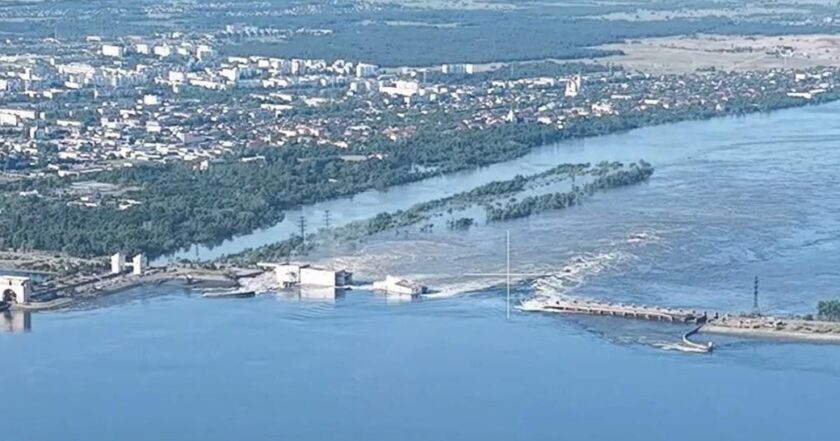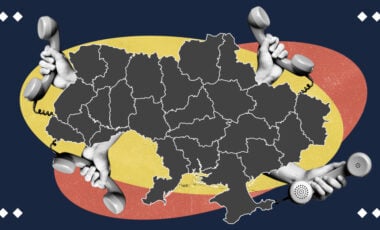Terrorist attack: Russian forces blow up Kakhovka hydroelectric power plant in Ukraine's Kherson region

Kakhovka HPP is destroyed
On the night of June 6, Russian invaders blew up the Kakhovka hydroelectric power plant (HPP), located a few kilometers from the temporarily occupied city of Nova Kakhovka in Ukraine's southern Kherson region. Because the dam was destroyed, the water in the Kakhovka reservoir began to fall rapidly, threatening to flood Kherson and nearby towns and villages.
Rubryka reports, referring to the statement of the head of the Kherson regional military administration, Oleksandr Prokudin, on the Telegram messaging app.
Kherson journalist Kostiantyn Ryzhenko reported on the terrorist act by the Russian occupiers on the morning of June 6, publishing footage of the consequences on his Telegram channel. Later, the military, officials, and the Ministry of Internal Affairs confirmed the information about the hydraulic structure's explosion.
On Tuesday night, Russian propagandists massively began to accuse the Ukrainian army of blowing up the plant. According to official data, the Defense Forces of Ukraine did not conduct any military operations in this area.
This morning, the spokesperson of the South operational command, Vladislav Nazarov, confirmed the blowing up of the Kakhovka HPP by Russian troops.
The Kakhovka HPP is located a few kilometers from the temporarily occupied city of Nova Kakhovka in the Kherson region.
"Currently, the scale of the destruction, the speed and volume of water, and the likely flooding areas are being clarified. All services are working," Prokudin noted.
As it became known, the Russian occupiers also blew up the turbines and generators of Kakhovska HPP.
Satellite images of the blown-up HPP were shared by Maxar Technologies, Reuters reports.
Ukrainian authorities' response
In his Telegram channel, the Secretary of the National Security and Defense Council (NSDC) Oleksii Danilov wrote:
"President of Ukraine Volodymyr Zelensky decided to hold an emergency meeting of the NSDC of Ukraine about the explosion of the Kakhovska reservoir dam."
In turn, the head of the President's Office, Andrii Yermak, published a video of the consequences of Russia's blowing up the Kakhovska HPP on his Telegram and declared that the Russian army would answer for it.
"This is ecocide. The Russians will be responsible for the possible deprivation of drinking water for people in the South of the Kherson region and the Crimea, the possible destruction of some settlements, and the biosphere. Also, their actions pose a threat to the Zaporizhzhia Nuclear Power Plant," he wrote.
Evacuation of residents
As the head of the region noted, the official authorities announced the urgent evacuation of the population of dangerous areas.
"The Russian army carried out another act of terror. It blew up the Kakhovska HPP. In five hours, the water will reach a critical level, and the evacuation of residents of dangerous areas has begun. Please collect documents and essential items and wait for the evacuation buses," said Prokudin.
He also separately appealed to the residents of the left bank, which is occupied by Russian forces, and urged them to do everything possible to save their lives.
"Immediately leave the dangerous area," he emphasized.
The Ministry of Internal Affairs of Ukraine reported the beginning of the evacuation of the civilian population from potential flooding zones on the right bank of the Dnipro River, namely: the villages of Mykolaivka, Olhivka, Lvove, Tiahinka, Poniativka, Ivanivka, Tokarivka, Prydniprovske, Sadove, and partially the city of Kherson, Korabel District.
The post notes that the water level is rising, and everyone who is in the danger zone needs to:
- turn off all electrical appliances
- take documents and necessities
- take care of loved ones and pets
- follow the instructions of rescuers and police officers
"And remember: the enemy is trying to spread misinformation, to remove responsibility for another crime," said the Ministry of Internal Affairs.
What we know about Kakhovka HPP
The Russian invaders captured the main structure of the North Crimean Canal and the Kakhovka HPP on February 24 last year at the beginning of Russia's invasion of Ukraine.
Kakhovka HPP is located 5 km from Nova Kakhovka, captured by the Russians. Water intake for the North Crimean Canal, which the Russian occupiers have unblocked since the beginning of the invasion, is carried out precisely in the Kakhovka Reservoir.
This HPP is the lowest and last (sixth) stage in the cascade of Dnipro reservoirs. The hydroelectric power plant near Nova Kakhovka ensures annual regulation of the Dnipro flow so that the southern part of Ukraine has electricity and water.
On October 20, 2022, the President of Ukraine, Volodymyr Zelensky, already warned that Russia is preparing to stage a new large-scale terrorist attack — to blow up the Kakhovka HPP dam in the Kherson region. At the same time, he listed other consequences threatened by the undermining of the Kakhovska HPP and its dam:
- hundreds of thousands of residents of the south of Ukraine will be in the danger zone and may be affected by the triggered flood
- the water supply of a large part of the south of Ukraine and Crimea may be destroyed
- a Russian terrorist attack may leave the Zaporizhzhia nuclear power plant without water for cooling because the water for the ZNPP is taken from the Kakhovka Reservoir
- the overall devastating ecological, humanitarian, and man-made consequences of such a terrorist attack will reach the scale of a "historical catastrophe."
Later, the head of the Kherson City Military Administration, Halyna Luhova, appealed to the people of Kherson about Russia's preparation for a terrorist attack at the Kakhovka HPP. She published an algorithm of actions to take if a reservoir dam is blown up.
We will remind you that Rubryka previously warned that mining the Kakhovka HPP is a severe threat to the population of the temporarily occupied territories. Rubryka has prepared detailed instructions on how to act in the event of an explosion to save yourself and help others.




















































